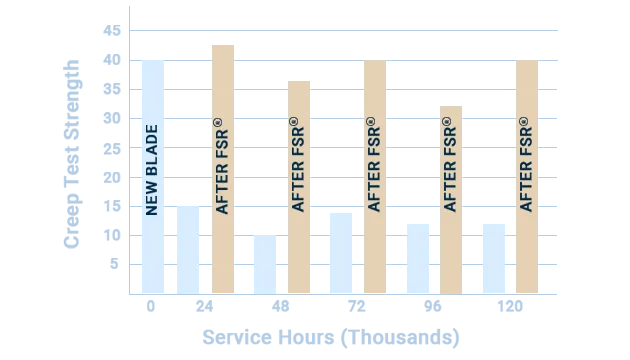Restore your gas turbine blades to OEM new-material specifications with Liburdi’s patented Full Solution Rejuvenation® (FSR®) process—extending blade life, reducing waste, and avoiding costly replacements.

Rising gas turbine blade replacement costs, long lead times, and wasted materials make every maintenance cycle more expensive. Most OEMs and repair shops retire blades after the second service interval—forcing costly new purchases.
Liburdi’s patented Full Solution Rejuvenation® (FSR®) process changes that. Operating for over 45 years with a 90% average repair yield rate, FSR® has successfully rejuvenated more than 500,000 blades for GE, Siemens, Westinghouse, Alstom, and Dresser-Rand turbines.
By restoring components to OEM new-material specifications (zero-hour condition), FSR® reliably extends blade life for two to three additional service intervals, avoiding major capital expenditures and reducing environmental waste. The result—hundreds of thousands in savings, improved efficiency, and a sustainable, proven alternative to replacement.

Liburdi’s patented Full Solution Rejuvenation® (FSR®) process brings gas turbine blades back to life by reversing the effects of alloy aging. Over time, exposure to high service temperatures causes microstructural degradation—including coarsening of gamma prime precipitates, carbide degeneration, and grain boundary coarsening—which limits blade life.
During FSR® blade rejuvenation processing, high-temperature treatment dissolves these degraded gamma prime precipitates. Controlled aging heat cycles then reform them into their ideal size and distribution, restoring the alloy’s microstructure and strength to zero-hour, OEM-grade condition.
Tailored to each blade alloy and manufacturing specification, Liburdi’s process combines advanced stripping, precision coating replacement, and proprietary heat treatment to ensure optimized performance, extended turbine life, and reliable results across every service interval.


Liburdi’s gas turbine blade repair process goes beyond restoration. Each blade rejuvenated through our Full Solution Rejuvenation® (FSR®) process is qualified using the ASTM E139 Stress-Rupture Test, the same standard used for new OEM parts.
As a final certification step, FSR®-processed blades must meet or exceed OEM new-part specifications, verifying complete recovery of alloy strength and test properties. Results consistently demonstrate full restoration, returning blades to “better-than-new” condition with reliable, repeatable performance.
With over four decades of proven success, Liburdi’s rigorous testing standards ensure your turbine components deliver OEM-grade quality and long-term reliability every cycle.
For more than 45 years, Liburdi’s Full Solution Rejuvenation® (FSR®) process has set the benchmark for gas turbine blade repair and life extension. Introduced by Liburdi in 1979, FSR® has a proven record of success across high-performance alloys including MM247, GTD111, and Rene 80.
Blades can be rejuvenated multiple times through the FSR® process, with many sets achieving two or three additional service intervals and surpassing 100,000 hours of operation. These results continue to demonstrate the reliability, strength, and longevity operators worldwide expect from Liburdi’s repair technologies.
With Liburdi, you’re not just maintaining turbine components; you’re maximizing their performance potential.

Hot Isostatic Pressing (HIP) uses high temperature and pressure to eliminate porosity in metal castings. When turbine blades return from service, small voids known as creep cavities can weaken the alloy. HIP closes these cavities, restoring casting integrity and improving long-term performance.
Different alloys require customized HIP cycles. Liburdi’s engineering team carefully designs, tests, and verifies each process to ensure safety and effectiveness. Every batch is validated through metallography and mechanical testing to confirm full process success.
Yes. Applying Full Solution Rejuvenation® (FSR®) at each shop visit ensures blades return to service in an as-new strength condition. Skipping a cycle may leave blades with reduced strength, increasing operational risk in the event of firing errors or impact damage. Best practice is to apply FSR® blade rejuvenation at every major repair interval to maintain full design strength, operational flexibility, and peace of mind.
The metallurgical aging and creep that occur during service are fully reversible through FSR®’s specialized heat treatments. The process can be safely repeated multiple times. In fact, record sets have achieved six rejuvenation cycles, accumulating close to 200,000 hours of service, demonstrating the true longevity of Liburdi’s gas turbine blade repair technology.